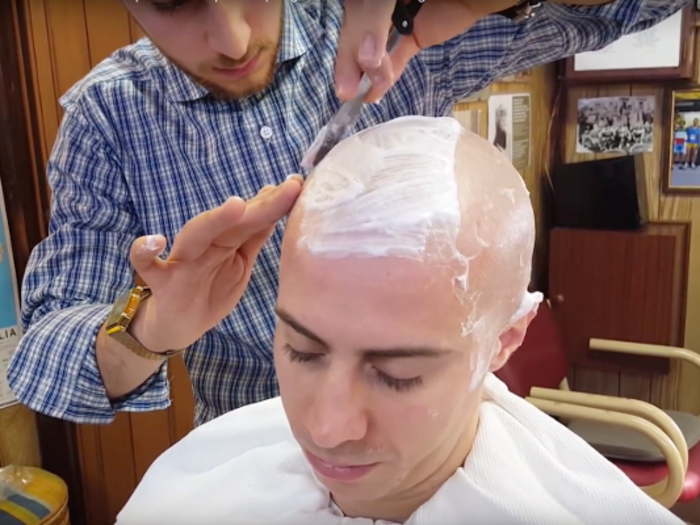
If something gives you the "brain tingles" — even if it's as unusual as crunching into raw honeycomb like this one from YouTube user SAS-ASMR — that's a video.
Massimo Tarantelli, who owns ASMR Barber and told Business Insider he generates $2,000 a month from it, noticed that barbershop visits provided a cornucopia of ASMR triggers — a brush painting foam on one's face, the buzz of a razor, the clean sweeping sound of scissors.
Tarantelli didn't know this was ASMR until he discovered the YouTube world of brain tingles. In 2013 he decided to start recording his visits to the barbershop, and later to masseuses as well.
Tony Bomboni ASMR said he has a notebook where he writes inspirations from his daily life, to later become ASMR videos. A day at the beach, for instance, could later become a video where he applies sunscreen lotion and bronzing spray.

Olivia Kissper, who joined YouTube in 2013, said it usually takes her around 30 hours to make a single ASMR video, because of the time it takes to research and write the script.
She said she looks at what people are searching on ASMR YouTube for video ideas; this shows her what people are most interested in.
"For me, it's all about ideas and coming up with something useful," Kissper told Business Insider.
Kissper also said she's enjoyed exploring "transformational art," like her videos that will "get you high" and inspire lucid dreaming.
Those videos require the most research and preparation, often up to a few months.

Emma Smith of WhispersRedASMR said she started off with a simple camcorder for both sound and video, but then added a Zoom H4N, which cost around $200, to record sound separately. This is a microphone that is commonly used in music, film, and podcasting.
Now, Smith records in stereo, which means she uses two or more microphones at a time. She might use a microphone on her lapel as well as several others "dotted around the room," she said.
She also uses lighting and a Panasonic GF6, a 16-megapixel camera that retails for $330 and up.
Tony also uses a Zoom H4N microphone, as well as a Blue Microphones Spark microphone ($200) and is an "enthusiast" of the 3Dio brand ($500 to $2,000). 3Dio microphones are binaural, meaning it attempts to capture sounds exactly the way humans perceive them.
The prices may be intimidating, but Smith said beginners needn't shell out their savings. "Just use whatever equipment you can afford," Smith told Business Insider.
ASMR Academy recommends the Yeti Microphone ($129) as a microphone for beginners.
Emma Smith, or WhispersRed, said if you're especially interested in presentation or graphic design, that can also be incorporated into your videos — sound and visuals work in harmony.

Bamboni said he tells newbies to the ASMR seen to start off slowly. Otherwise, you might get overwhelmed, burned out, or realize you might not be interested in YouTube after all.
"Don't post everyday," Tony said. "Start off once a week or once a month and see where it takes you."
Smith said she makes one video per week.

Few YouTubers can rely on their channel alone for money.
Kissper told Business Insider that she makes most of her money through Patreon, a website that allows users to build a subscription service for their content.
That provides a steady income of more than $1,000 per month, plus around $1,000 from YouTube. Though YouTube provides a platform for her ASMR videos, it's not the most dependable source of income as it relies heavily on ads and viewership.
"There's no steadiness," Kissper said. "Sometimes my views go up and sometimes they go down."
Unlike many YouTube channels, most ASMR YouTubers don't promote many products, so their YouTube revenue must come straight from ads. Corrina Rachel, who operates the YouTube wellness and ASMR channel PsycheTruth, said her YouTube income has been slashed to a quarter of what it once was after YouTube restructured its advertising model.
Kissper said she just promotes one to two products — one of which is an online counseling service. "A lot of people who watch my videos express some sort of anxiety or depression or stress so I thought it would be good to provide that to them."

Bomboni told Business Insider that aspiring ASMR YouTubers need to be themselves in order to enjoy the community and gain a following.
"Try not to focus too much on what other ASMR artists are doing, and try not to copy other personalities," Tony said. "Be authentic to yourself and genuine."
Smith had similar advice. "It's just really important to not put too much pressure on yourself to be a success at it, because then you end up being someone else."
 Global stocks rally even as Sensex, Nifty fall sharply on Friday
Global stocks rally even as Sensex, Nifty fall sharply on Friday
 In second consecutive week of decline, forex kitty drops $2.28 bn to $640.33 bn
In second consecutive week of decline, forex kitty drops $2.28 bn to $640.33 bn
 SBI Life Q4 profit rises 4% to ₹811 crore
SBI Life Q4 profit rises 4% to ₹811 crore

Copyright © 2024. Times Internet Limited. All rights reserved.For reprint rights. Times Syndication Service.